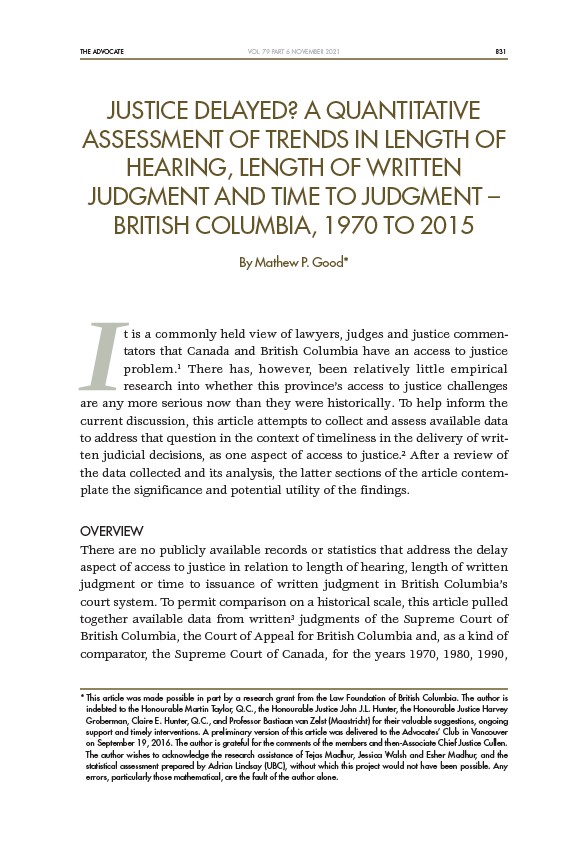
THE ADVOCATE 831
VOL. 79 PART 6 NOVEMBER 2021
JUSTICE DELAYED? A QUANTITATIVE
ASSESSMENT OF TRENDS IN LENGTH OF
HEARING, LENGTH OF WRITTEN
JUDGMENT AND TIME TO JUDGMENT –
BRITISH COLUMBIA, 1970 TO 2015
By Mathew P. Good*
It is a commonly held view of lawyers, judges and justice commentators
that Canada and British Columbia have an access to justice
problem.1 There has, however, been relatively little empirical
research into whether this province’s access to justice challenges
are any more serious now than they were historically. To help inform the
current discussion, this article attempts to collect and assess available data
to address that question in the context of timeliness in the delivery of written
judicial decisions, as one aspect of access to justice.2 After a review of
the data collected and its analysis, the latter sections of the article contemplate
the significance and potential utility of the findings.
OVERVIEW
There are no publicly available records or statistics that address the delay
aspect of access to justice in relation to length of hearing, length of written
judgment or time to issuance of written judgment in British Columbia’s
court system. To permit comparison on a historical scale, this article pulled
together available data from written3 judgments of the Supreme Court of
British Columbia, the Court of Appeal for British Columbia and, as a kind of
comparator, the Supreme Court of Canada, for the years 1970, 1980, 1990,
* This article was made possible in part by a research grant from the Law Foundation of British Columbia. The author is
indebted to the Honourable Martin Taylor, Q.C., the Honourable Justice John J.L. Hunter, the Honourable Justice Harvey
Groberman, Claire E. Hunter, Q.C., and Professor Bastiaan van Zelst (Maastricht) for their valuable suggestions, ongoing
support and timely interventions. A preliminary version of this article was delivered to the Advocates’ Club in Vancouver
on September 19, 2016. The author is grateful for the comments of the members and then-Associate Chief Justice Cullen.
The author wishes to acknowledge the research assistance of Tejas Madhur, Jessica Walsh and Esher Madhur, and the
statistical assessment prepared by Adrian Lindsay (UBC), without which this project would not have been possible. Any
errors, particularly those mathematical, are the fault of the author alone.